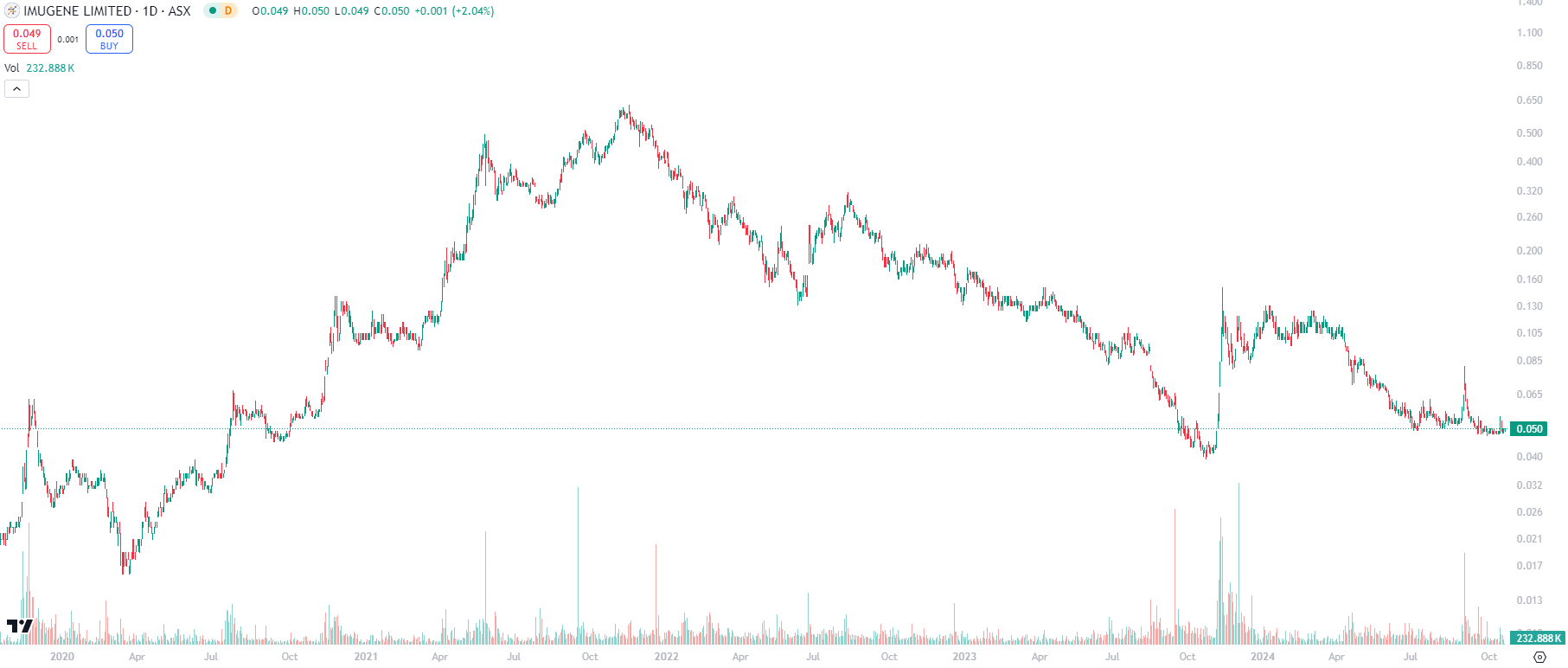Imugene (ASX:IMU): This exciting biotech has multiple clinical trial readouts expected in the next 12 months

Imugene (ASX:IMU) is still valued at over $400m, in spite of being valued at over $2bn back in 2021 and having had a rollercoaster 12 months.

Imugene (ASX:IMU) share price chart, log scale (Source: TradingView)
Even though it has assets that have passed Phase 2 trials, it has never gotten to Phase 3. Yet it has $93.1m in cash and is capped at nearly $400m. Just where is this company at? Will it ever bring a product to market? Let’s take a look.
Recap of Imugene’s therapies
Imugene has 3 therapies:
- Azer-Cel CAR-T Cell Therapy
- CF33 Oncolytic Virus (Vaxinia), and
- onCARlytics.
We shouldn’t proceed further without recapping what CAR-T is, given Imugene is in the CAR-T therapy space with Azer-Cell and onCARlytics. CAR-T is a therapeutic approach that utilises a body’s own immune system to fight cancer. It extracts T-cells from a patient’s blood and then genetically engineers them to produce Chimeric Antigen Receptors on their surface which directs a T-cell response to that specific cancer antigen.
The patient then receives that therapy in an infusion that can target and destroy cancer cells. The world’s first CAR-T therapy, Kymriah from Novartis, was only approved in 2017, but has never looked back – sales are over US$1bn a year. CAR-T is so promsing can work in rarer cancers and in patients where previous treatments have failed.
With Azer-Cell, the company demonstrated positive outcomes in a trial for B-cell lymphoma, a kind of blood cancer. It was only 10 patients, but 3 achieved a complete response and several others demonstrated sustained remission. The trial is ongoing, but the company is planning a robust data set for a Phase 2/3 trial submission to the FDA.
Looking briefly at Vaxinia, this is an engineered virus that is injected into the cancer cells, will infect and kill only them. Imugene has been working on it since 2019, when it picked up the company that possessed it. Vaxinia has shown promising results for Bile Cancer, and the company just received Orphan Drug Designation (ODD) for this indication.
onCARlytics is in its own Phase 1 trial too, for advanced or metastatic solid tumours in combination with blinatumomab.
A big couple of years are ahead
All 3 of Imugene’s assets have clinical data, extensive patent protection lasting well into the 2030s and Investigational New Drug Status from the FDA. The company is hoping to enter Phase 2 with all 3 of them in the next couple of years. It will be a long way to market, but the market will be lucrative if and when it is reached. Precedence Research has forecast that the CAR-T market, worth US$3bn in 2023, will reach US$23bn by 2033, representing an annual CAGR of 23.35%.
Obviously this will only happen if final Phase 1 results work well, but there is reason to be optimistic given the data to date. This company has for several years been led by Leslie Chong and by Paul Hopper – a well known figure in the ASX biotech space. Hopper is the largest shareholder with a 5.5% stake.
Conclusion
This company appears promising right now, and there’s no doubt there is a big sales opportunity when it can bring one or more of its therapeutics to market.
Nonetheless, we wouldn’t invest in it right now. We think $400m is too high a market capitalisation for a company that has not entered Phase 2. We also think the company needs to simplify its portfolio and focus on just one or two of its assets. We may revisit the company in a couple of years time, once it has entered Phase 2 for one of its assets.
What are the Best ASX Stocks to invest in right now?
Check our ASX stock buy/sell tips
Blog Categories
Get Our Top 5 ASX Stocks for FY26
Recent Posts
Is Telix Pharmaceuticals (ASX:TLX) Now Undervalued With Phase 3 China Clinical Success?
Why Telix Pharmaceuticals Pullback Could Be a Second Chance Telix Pharmaceuticals (ASX:TLX) has faced a challenging year, particularly for a…
Can AI predict future stock returns? Here’s what the statistics suggest!
Can AI predict future stock returns? Some might say yes, and even that artificial intelligence can outperform human analysts. Certainly,…
ASX Casino Stock Investment Analysis Guide
Investing in ASX-listed casino stocks demands a unique blend of market analysis and sector-specific insight. It is a high-stakes game…



